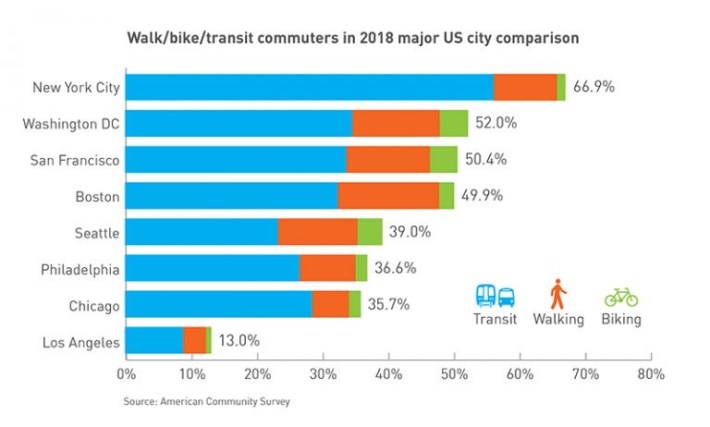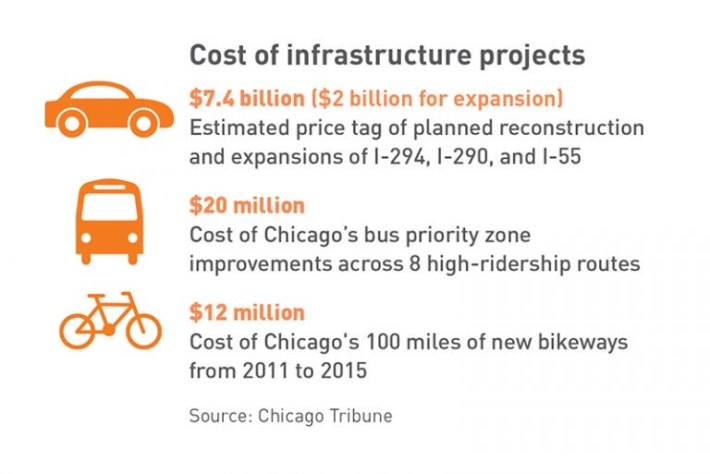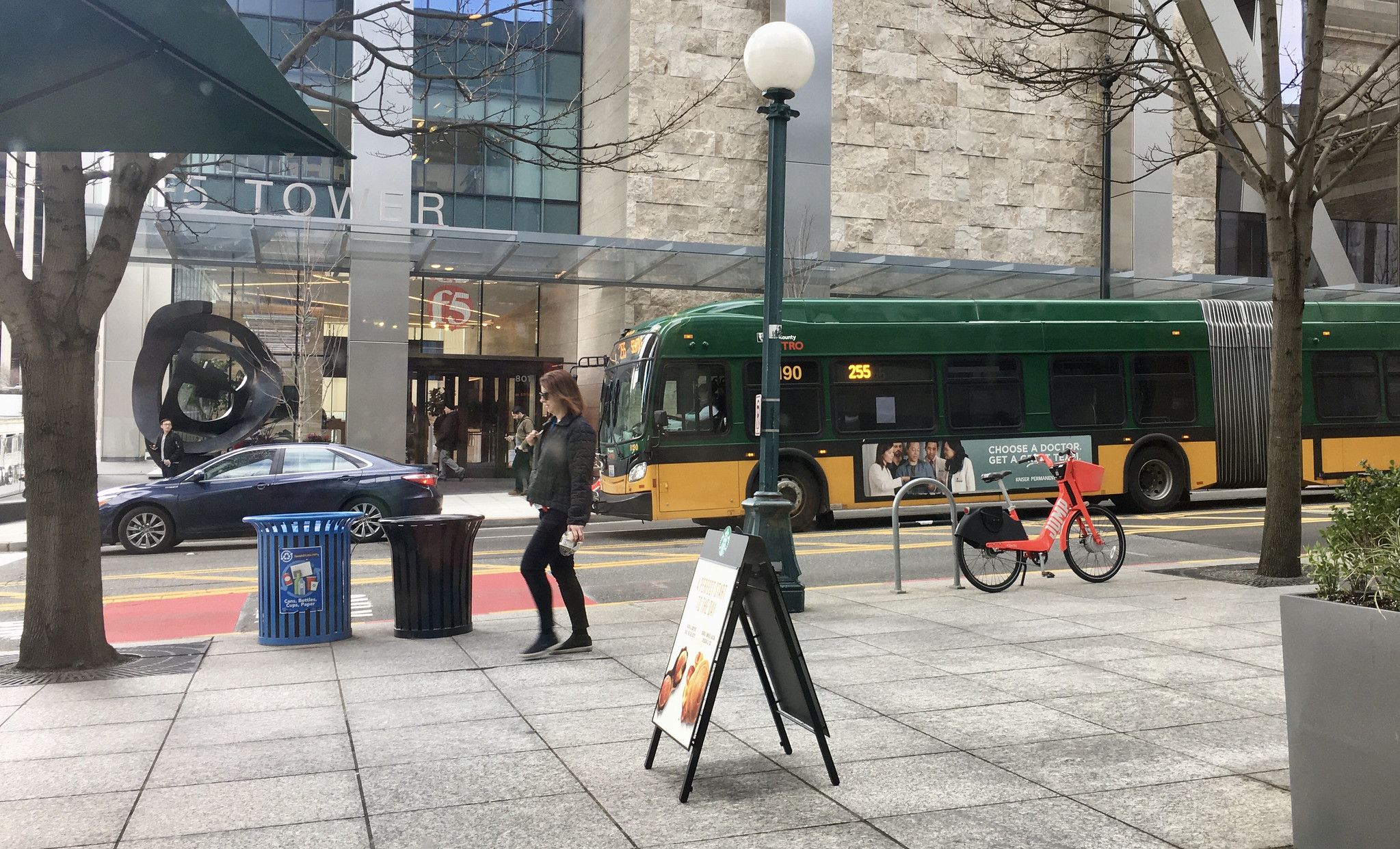The Active Transportation Alliance recently released its Regional Mode Share Report, a regularly published study of Chicagoland commute mode shares. 2020’s report shows that our city is falling behind peer cities when it comes to increasing the percentage of people walking, biking, and riding transit to work: Chicago moved from fifth to seventh place out of eight peer cities, with Seattle and Philadelphia pulling ahead of us.
There was growth in the percentage of people working from home and the percentage using ride-hail. The growth in Uber and Lyft use has led to a serious decline in the number of people using transit. Overall, biking, walking, and transit mode share fell by 2 percent.

The report should't surprise anyone passionate about active and sustainable transportation in Chicagoland. There have been some encouraging recent developments, such as the $45 billion Illinois capital bill that passed in Springfield last year, which included $4.7 billion for transit over the first six years and $281 million for each year afterwards, plus an unprecedented $50 million a year set-aside for bike/walk infrastructure.
However, there's still too much emphasis on roads and highways. While the Active Transportation Alliance pushed for earmarking 40 percent of the transportation funding in the bill for transit, we only wound up with 23 percent, which is too small a slice of the pie. Just like folks will choose walking and biking when we make substantial investments in creating bikeable and walkable communities, it makes sense that people choose car-based transportation when the majority of transportation dollars are used to facilitate driving.
The Lori Lightfoot administration's $20 million Bus Priority Zone program is currently rolling out short stretches of bus lanes on high-ridership bus routes like Western and Chicago avenues and 79th Street. But as I've written before, this relatively modest investment will not be enough to entice large numbers of people to switch from driving or ride-hail to riding buses.
In addition, Lightfoot is opposing the South Cook Fair Transit Pilot proposal, which would create more affordable and frequent service on two South Side Metra lines. That's even though the plan is projected to result in an overall net transit ridership gain of 48,000 riders.

Recent or current CTA improvements include the south Red Line reconstruction, the Your New Blue rehab of the O'Hare branch, the Red and Purple Modernization project on the North Side, and new stations on the Green Line at Morgan (which also serves the Pink Line), Cermak, and Damen, as well as 95th and Wilson on the Red Line, and Skokie-Oakton on the Yellow line. But these have not been enough to stop ridership bleeding with the rise of ride-hail.
Chicago has built dozens of miles of protected bike lanes over the last decade, but we still don't have a cohesive "eight-to-eighty" bikeway network that people of all ages and abilities would feel comfortable using. Painted lines on the road aren't enough to make the average Chicagoan consider transportation cycling.
There's hope, however. In recent years Seattle has added hundreds of thousands of new residents while simultaneously decreasing driving, offering a possible blueprint for increasing Chicago's sustainable mode share. The number of commuters driving solo in the Seattle region dropped from 53 percent in 2010 to 44 percent in 2018.
As reported in Politico, between 2014 and 2017, Seattle residents voted to raise taxes to expand bus service; build transit, bike and pedestrian amenities; and expand the region’s light-rail system. A successful 2016 advocacy campaign resulted in a $54 billion tax levy spread out over 25 years that will fund this infrastructure.
While proper sustainable transportation funding is obviously key, other state and city policies also made a difference. Washington State has a Growth Management Act which requires local government to prevent sprawl, and a Commute Trip Reduction law which requires large employers to work to reduce the number of employees driving alone to work.
Illinois does not have such policies, nor has the city of Chicago or local transit agencies done much to proactively work with large companies to reduce the amount of employees driving alone to work. However, Lightfoot made this campaign promise:
Working with City Council, my administration will draft a Chicago Commute Trip Reduction Ordinance to reward workers who bike or walk to work. This ordinance will call on large businesses to create employee transportation plans that encourage employees to walk, bike, carpool, and/or take public transportation to and from work. Through tax and regulatory incentives, we will encourage employers to reward employees who do not drive to work.
There’s also an equity component at work: Washington State requires Sound Transit, the regional transit authority, to build affordable housing on the land used for construction staging for new light rail lines. Residents in these buildings are further assisted by the ORCA Lift program, which provides reduced fares for people with a monthly household income of less than 200 percent of the federal poverty level. Active Trans has advocated for a similar program in Chicagoland in their recently released Fair Fares Chicagoland report.
Compare Seattle’s progressive transit-oriented land use policies with say, the Berwyn Red Line station with its huge Jewel parking lot, or the massive, largely empty parking structure Truman College built near the Wilson stop. There are many locations across Chicago where we could build equitable transit-oriented development to provide low-income and working-class residents with great public transportation access, helping to connect them with employment and educational opportunities. The upcoming 100-percent affordable TOD by the Logan Square Blue Line station is a great example of this tactic.
An outcome of Seattle’s investments I was really excited to read about was the increase in folks who are within a 10 minute walk of a bus with a 10-minute frequency or better. In 2014 just 25 percent of Seattle residents were within a 10-minute walk of a high frequency bus, but in just three years time that number more than doubled to 64 percent. Considering Chicago’s convenient grid, which Seattle lacks, it would make sense for our city to aim for giving at least 75 percent of residents this kind of transit access.
Of course, buses need to be fast as well as frequent to attract new riders. That's why we should implement time-saving features like camera-enforced bus lanes, prepaid, all-door boarding, and transit signal priority on all high-ridership routes.
Chicago can learn a lot from Seattle and other cities that have made major investments in transit, walking, and biking so that we can shift more of our trips to sustainable modes. Ridership follows investment and Chicago has a lot of room for improvement.
What would you recommend to shift more Chicagoland trips to transit, walking, and biking?





